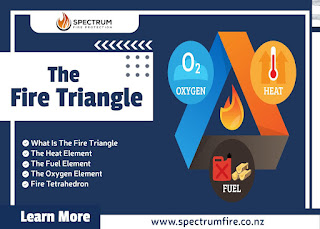The Fire Triangle
The fire triangle, also known as the combustion triangle, consists of three vital components – heat, fuel, and oxygen. The three components are essential to start and sustain a fire.
The fire can’t be ignited, or it will extinguish almost immediately, even if one of these three ingredients are missing. So, how does this work?
As mentioned earlier, the three components of a fire triangle are
- Fuel
- Oxygen
- Heat
To put out a fire, the focus should be to eliminate at least one of these components.
The market is filled with many different types of fire extinguishers that help eliminate one or several of these components to put out a fire.
Whenever there’s a fire, the first and the most used natural extinguisher that comes to mind is water. Water eliminates the heat component, which effectively helps put out a fire.
Similarly, the foam-based fire extinguishers stop the fire from getting enough oxygen. The foam works on the same principle as a blanket to suppress and put out the fire, but more effectively.
In most cases, it is seen that cutting the fuel source is considerably difficult.
Now, let us elaborately discuss all these three fire triangle components!
The Heat
Without heat, the fire cannot start nor continue. As stated earlier, the most efficient method of cutting out heat from a current fire is through the water.
During a fire caused due to electrical short circuit or any other form of an electrical fire, the heat component can be eliminated by simply switching off the main electrical power.
The hot burning embers can be swiftly removed when a fire is caused in a large structure. It helps reduce the effectiveness of the heat component, making it easier to put out the fire.
The Fuel
Fuel allows the fire to continue sustaining. The fire cannot continue without fuel once the available fuel is used.
During a fire breakout and fire emergencies, the priority is to put out the fire as soon as possible, mitigating loss and damage. So, if the fuel can be removed safely from contact with the fire, it must be done.
The fuel from the fire source can be removed manually or by using chemical-based fire extinguishers or a suitable alternative. Cleaning and removing the fuel physically is risky and must be done cautiously.
When a fire breaks out, it uses any potentially flammable material as fuel. It is critical to clean out any such materials from the surroundings to keep the fire from growing further or prevent another fire breakout.
The Oxygen
Fire cannot start, grow, or sustain without oxygen. Foam based fire extinguishers or fire blanket is often used to keep the fire from getting enough oxygen to sustain.
It creates a protective layer between the fire and the oxygen, ensuring the fire is put out or limiting its growth substantially.
In the absence of oxygen, the fire doesn’t burn itself out. Typically, there’s sufficient oxygen available for the fire to continue indefinitely.
Fire Tetrahedron
Just like Fire Triangle, there’s another concept called Fire Tetrahedron. In this concept, another vital component is added: chemical reaction.
In fires caused due to chemical reactions involving several volatile or combustive metals and elements like magnesium, titanium, lithium, etc., the firefighters have to use a different, more complex approach.
The fires caused by chemical reactions are classified as Class D fires. Using water to extinguish the fire in these cases would only exacerbate it. This calls for using inert agents such as sand to neutralize the fire.
A comprehensive understanding of the fire triangle is an integral aspect of fire fighting education. It helps understand the fire elements more intricately, preparing you to handle fire breakouts and fire emergencies from an informed position.
From Spectrum Fire Protection The Fire Triangle



Comments
Post a Comment